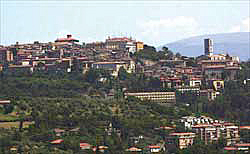 Perugia is the capital city in the region of Umbria in central Italy, near the Tiber river, and the capital of the province of Perugia.
Perugia is the capital city in the region of Umbria in central Italy, near the Tiber river, and the capital of the province of Perugia.Perugia is an important artistic center of Italy. The town gave his nickname to the famous painter Pietro Vannucci, called Perugino, who worked in Perugia, Rome and Florence. Perugino is said to be the Maestro of Raffaello, who left in Perugia five paintings (today no longer in the city) and one fresco. Another famous painter, Pinturicchio, lived in Perugia. In Galeazzo Alessi Perugia found its most famous architect.
Perugia first appears in history as Perusia, one of the twelve confederate cities of Etruria. It is first mentioned in the account of the war of 310 or 309 BCE between the Etruscans and the Romans. It took, however, an important part in the rebellion of 295, and was reduced, with Vulsinii and Arretium (Arezzo), to seek for peace in the following year
In 1832, 1838, 1854 and 1997 Perugia was visited by earthquakes; Following the collapse of the Roman republic of 1848-49, when the Rocca was in part demolished, in May 1849 it was seized by the Austrians. After another futile insurrection in the June of 1859, which was bloodily defeated by Pius IX's troops, it was finally united, along with the rest of Umbria, to Piedmont, in 1860.